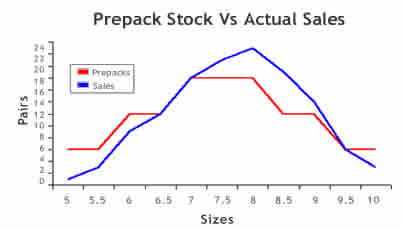|
Unfortunately,
all too often the link between supply and demand is broken or is
not too precise. Many retailers receive shipments of merchandise
from their suppliers in “prepacks” and then send these
along straight to their stores, believing incorrectly that a) the
relevant unit of analysis is the style and not the item and/or b)
that it is not worth the time and effort to place orders, and sort
them in their warehouses, at the item level (size & color).
This is a serious mistake, since prepacks by definition follow a
standard distribution of sizes, usually some variation of a bell
curve. However, human beings do not fit neat statistical patterns
and every time we have run Size Distribution of Sales reports for
our customers, we have been surprised by how much variation we see:
a particular woman’s black boot may sell a lot of sizes 8s
and 5s and the same boot in a different color may sell a lot of
6s and 5s while a similar boot with a higher heel may sell predominately
sizes 9 and 10. Customers are a wonderfully varied lot and making
it impossible to predict the distribution of your sales with any
great accuracy.
Retailers
whose distribution system relies on prepacks are without a doubt
carrying substantially sub-optimal inventory. Usually, items in
the middle of the size run sell out first, at which point the retailer
then orders another prepack to restock that item as quickly as possible,
but the other sizes, particular those on the end of the size run,
have not sold out, so excess inventory begins to accumulate. In
the graph below, we have shown a hypothetical example where the
prepack follows an even distribution in increments of 6, 12 and
18 pairs while the actual sales follow a more random distribution,
in this case, showing that larger sizes are more popular for this
style. For those sizes where sales are below the prepack level (sizes
5 – 6.5 & 10) the retailer is overstocked; for those sizes
where sales are above the prepack (sizes 7.5 – 9) the retailer
is understocked. This leaves the retailer with two unpleasant options:
order another prepack, in which case he will accumulate even more
unnecessary stock (in sizes 5 – 6.5 & 10) or wait till
he sells the remaining inventory in these sizes in which case he
is losing sales in the sizes that are out of stock (sizes 7.5 –
9). The problem is multiplied every time the retailer reorders a
prepack or waits to sell-down inventory. We had one customer whom
we discovered had 24 pairs in inventory of the smallest size of
a particular style. Why 24? He had ordered 24 prepacks in the last
year every time the best-selling size sold out and not once had
he sold a shoe in the smallest size. Every time he ordered a prepack
he was accumulating a souvenir--and a very expensive one at that!

Some
retailers know prepacks are inaccurate but argue that it is not
worth the extra expense to implement an item-based inventory control
system that gives them greater accuracy. These retailers’ main
concern is speed: they like to order the prepacks from their vendors
and deliver them as is to their stores, the quicker the better,
to make room for the next shipment. Our experience has shown that
typically a quarter of a retailer’s inventory is stagnant,
i.e. stock levels are much higher than sales while sales could be
20% higher if they made sure to never be sold out of items that
customers are looking for. These are huge numbers that translate
into substantial profits and far outweigh the additional costs that
controlling inventory at the item level entail. Information is a
lot cheaper than shoes or transportation costs. Regarding the argument
that item-based inventory control slows down the distribution system,
remember our friend the Chicago retailer whose sales kept growing
but profits were disappearing¾a clear case of over-supply
ruining GMROI (Gross Margin Return on Investment). Speed is not
an inherently good thing to have; it is a catalyst and will accelerate
the consequences of your decisions, good or bad. If excess inventory
is eating away at your profits, then selling and ordering even more
prepacks will not help. The goal of any retail operation, after
all, is higher profits, not necessarily more sales that drag down
the bottom line.
Now
prepacks are not a uniformly bad idea. If a given stores has a certain
sales volume then maybe it wouldn’t hurt to send them one prepack
to start off with, but then they need to fill in per size color
as the initial shipment sells to improve accuracy. Often vendors
allow you to order “pre-packs” and one-size packs (for
example 12 pairs of size 9). So based on past experience you could
track that you need one prepack per store plus a certain amount
of one size packs per certain sizes. Our point here is that you
need an automated system to be able to fill in the holes where these
extra shoes are needed. It will not always be the same size at the
same store.
The
strength of a big chain of stores versus a single store should be
their ability to statistically “even out” their sales.
In any given sales period, a certain store can sell an unusual amount
of size nines while another can sell a weird amount of size 6. However,
when you take the sales of the full 40 stores it will be unusual
for there to be extreme variations in sizes versus the past history
for that type or department of shoe. However, when variations do
appear, the retailer needs to adjust inventory levels. Even small
variations can have a large impact over time. The way to cover these
variations is through an item-based automatic resupply system, and
for that you need to use Minimums & Maximums.
|
 |